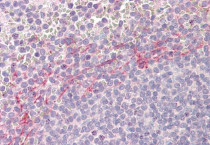ARG59750
anti-APOBEC 3D antibody
anti-APOBEC 3D antibody for IHC-Formalin-fixed paraffin-embedded sections,Western blot and Human
Overview
| Product Description | Goat Polyclonal antibody recognizes APOBEC 3D |
|---|---|
| Tested Reactivity | Hu |
| Tested Application | IHC-P, WB |
| Host | Goat |
| Clonality | Polyclonal |
| Isotype | IgG |
| Target Name | APOBEC 3D |
| Antigen Species | Human |
| Immunogen | Synthetic peptide corresponding to aa. 61-74 of Human APOBEC 3D. (NP_689639.2. C-PKRQSNHRQEVYFR) |
| Conjugation | Un-conjugated |
| Alternate Names | A3D; ARP6; APOBEC3E; APOBEC3DE |
Application Instructions
| Application Suggestion |
|
||||||
|---|---|---|---|---|---|---|---|
| Application Note | WB: Recommend incubate at RT for 1h. IHC-P: Antigen Retrieval: Steam tissue section in Citrate buffer (pH 6.0). * The dilutions indicate recommended starting dilutions and the optimal dilutions or concentrations should be determined by the scientist. |
||||||
| Observed Size | ~ 45 kDa |
Properties
| Form | Liquid |
|---|---|
| Purification | Affinity purified |
| Buffer | Tris saline (pH 7.3), 0.02% Sodium azide and 0.5% BSA. |
| Preservative | 0.02% Sodium azide |
| Stabilizer | 0.5% BSA |
| Concentration | 0.5 mg/ml |
| Storage Instruction | For continuous use, store undiluted antibody at 2-8°C for up to a week. For long-term storage, aliquot and store at -20°C or below. Storage in frost free freezers is not recommended. Avoid repeated freeze/thaw cycles. Suggest spin the vial prior to opening. The antibody solution should be gently mixed before use. |
| Note | For laboratory research only, not for drug, diagnostic or other use. |
Bioinformation
| Gene Symbol | APOBEC3D |
|---|---|
| Gene Full Name | apolipoprotein B mRNA editing enzyme catalytic subunit 3D |
| Background | This gene is a member of the cytidine deaminase gene family. It is one of a group of related genes found in a cluster, thought to result from gene duplication, on chromosome 22. Members of the cluster encode proteins that are structurally and functionally related to the C to U RNA-editing cytidine deaminase APOBEC1 and inhibit retroviruses, such as HIV, by deaminating cytosine residues in nascent retroviral cDNA. [provided by RefSeq, Jul 2008] |
| Function | DNA deaminase (cytidine deaminase) which acts as an inhibitor of retrovirus replication and retrotransposon mobility via deaminase-dependent and -independent mechanisms. Exhibits antiviral activity against vif-deficient HIV-1. After the penetration of retroviral nucleocapsids into target cells of infection and the initiation of reverse transcription, it can induce the conversion of cytosine to uracil in the minus-sense single-strand viral DNA, leading to G-to-A hypermutations in the subsequent plus-strand viral DNA. The resultant detrimental levels of mutations in the proviral genome, along with a deamination-independent mechanism that works prior to the proviral integration, together exert efficient antiretroviral effects in infected target cells. Selectively targets single-stranded DNA and does not deaminate double-stranded DNA or single-or double-stranded RNA. May inhibit the mobility of LTR and non-LTR retrotransposons. [UniProt] |
| Calculated MW | 47 kDa |
Images (2) Click the Picture to Zoom In
-
ARG59750 anti-APOBEC 3D antibody IHC-P image
Immunohistochemistry: Paraffin-embedded Human spleen tissue. Antigen Retrieval: Steam tissue section in Citrate buffer (pH 6.0). The tissue section was stained with ARG59750 anti-APOBEC 3D antibody at 3.75 µg/ml dilution followed by AP-staining.
-
ARG59750 anti-APOBEC 3D antibody WB image
Western blot: 35 µg of A549 cell lysate (in RIPA buffer) stained with ARG59750 anti-APOBEC 3D antibody at 0.3 µg/ml dilution and incubated at RT for 1 hour.







